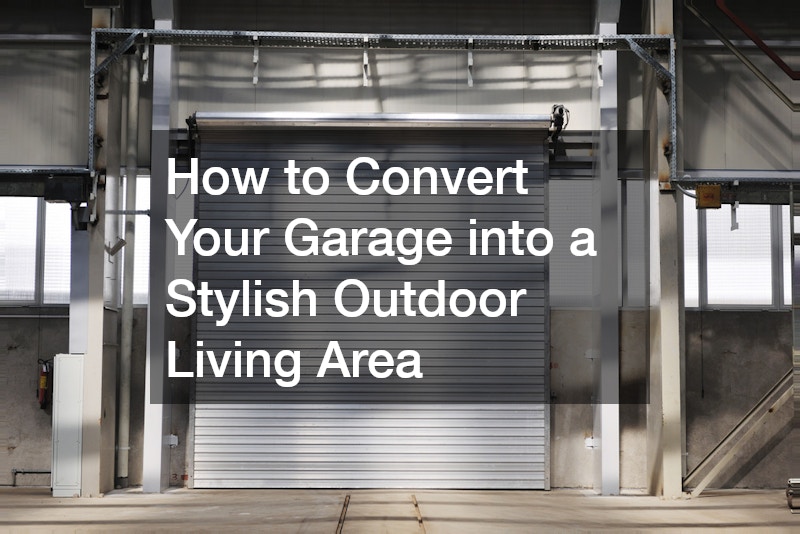The idea of maximizing every square foot of your home is becoming increasingly important. One trend that’s gaining traction is converting underutilized garages into beautiful outdoor living spaces. With the right design and execution, you can transform your garage from a cluttered storage area into a functional, stylish outdoor retreat that adds value and charm to your home.
In this guide, we’ll explore how to convert your garage into an outdoor living area, including design considerations, materials, and practical steps. We’ll also touch on integrating covered outdoor living spaces into your garage conversion for ultimate comfort and usability.
Why Convert Your Garage into an Outdoor Living Space?
Many homeowners have garages filled with items they rarely use or don’t use at all. Rather than letting this space go to waste, you can convert it into something that serves as an extension of your home. Here are a few reasons to consider this project:
- Expand Living Space: Garage conversions allow you to expand your living area without needing an expensive home extension.
- Increase Property Value: A well-designed garage conversion can significantly boost the value of your home.
- Create Versatile Spaces: Garages can be transformed into multi-functional lounges, dining areas, or even outdoor kitchens.
- Connect Indoors and Outdoors: By converting your garage, you seamlessly blend your indoor space with outdoor living areas.
Step-by-Step Guide to Converting Your Garage
1. Assess Your Garage’s Condition
Before diving into the design process, evaluate your garage’s structural condition. Check the flooring, walls, and roof for any signs of damage or areas that may need repairs.
- Flooring: Is the concrete stable and level?
- Insulation: Is your garage insulated, or will you need to add insulation to make it comfortable year-round?
- Walls & Roof: Look for leaks, cracks, or signs of moisture, as these issues must be addressed before the conversion.
2. Choose the Function of Your New Outdoor Living Space
Decide how you’ll use your converted garage. Here are some popular options:
- Outdoor Lounge: Ideal for relaxing or entertaining guests.
- Outdoor Kitchen: Perfect for those who love hosting cookouts and dinner parties.
- Dining Area: Create a stylish space to enjoy meals outside, regardless of weather.
- Multi-Functional Space: Combine multiple elements like a dining area, seating, and entertainment setup for versatility.
Once you’ve chosen your space’s primary function, you can start making design choices that match your vision.
3. Incorporate Covered Outdoor Living Spaces
When designing your converted garage, consider incorporating covered outdoor living spaces to protect the area from the elements while maintaining the outdoor atmosphere. A covered space adds functionality, as it allows you to enjoy your new living area year-round.
- Pergola: A popular option for semi-covered outdoor spaces that blend well with gardens and landscaping.
- Retractable Awning: Provides flexibility, offering shade when needed and opening up to sunlight when desired.
- Roof Extension: For a more permanent solution, extending your home’s roof to cover the garage’s new living space can create a fully functional room.
These covered options offer shade during hot days, protection from rain, and even shield your furniture from harsh weather conditions.
4. Plan for Climate Control
Depending on your location, climate control is essential for ensuring the comfort of your new outdoor living space. Here are some tips:
- Cooling: Install ceiling fans, add misting systems, or place portable fans to keep the area cool during the summer.
- Heating: Fire pits, patio heaters, or even built-in fireplaces can add warmth and ambiance to your garage living space during the cooler months.
- Ventilation: Ensure proper airflow to avoid the area feeling stuffy or damp, especially if you’re installing an outdoor kitchen.
5. Select Materials for Flooring, Walls, and Furniture
Choosing the right materials is essential to make your garage conversion functional and stylish. Here are some ideas:
- Flooring: Outdoor tiles, concrete with decorative stains, or wooden decking can give the space a polished, outdoor-appropriate look.
- Walls: To connect the area more to the outdoors, consider adding wood paneling, brick veneers, or even open walls with retractable screens.
- Furniture: Opt for weather-resistant furniture made from teak, aluminum, or all-weather wicker to withstand outdoor conditions.
Creative Design Ideas for Your Garage Conversion
1. Outdoor Lounge with a Fireplace
Transform your garage into a cozy outdoor lounge with comfortable seating and a built-in fireplace. Incorporate warm lighting and plush outdoor rugs to create a welcoming atmosphere. Adding a covered outdoor living space over your lounge area allows you to use it year-round, even during rain or intense sunshine.
2. Outdoor Kitchen and Dining Area
For food lovers, converting your garage into an outdoor kitchen can be a fantastic addition to your home. Include essential elements like a grill, refrigerator, and countertop space. A nearby dining area under a retractable awning will create the perfect setup for hosting family and friends.
3. Multi-Purpose Space for Entertainment
If you love versatility, create a space that caters to multiple activities. Include a dining table for meals, a comfortable seating area for lounging, and even a small bar. Incorporating a covered outdoor living space ensures you can enjoy all of these activities, rain or shine.
Convert Your Garage to Outdoor Living Space: Practical Considerations
1. Lighting
Proper lighting will make your converted garage more functional and inviting after the sun goes down. Outdoor string lights, wall-mounted lanterns, and recessed lighting in the ceiling can enhance the ambiance.
2. Plumbing and Electrical Work
If you’re creating an outdoor kitchen or lounge that requires appliances, you’ll likely need to hire professionals to run water lines, install sinks, and hook up electrical outlets. Ensure you consult with local professionals to make sure all installations comply with your local building codes.
3. Permits and Zoning Regulations
Converting a garage may require building permits, especially if you’re making significant structural changes or adding utilities like plumbing and electricity. Always check with your local municipality about any necessary permits before starting construction.
4. Maximizing Privacy
Since garage conversions are typically located at the front of a home, consider adding privacy elements such as trellises, screens, or vertical gardens. These features create an intimate setting and block the view from neighbors or passersby.
Maintenance Tips for Your New Outdoor Living Space
1. Regular Cleaning
Maintain your outdoor living space by regularly cleaning floors, furniture, and structures like pergolas or awnings. Keep cushions stored away when not in use, and clean outdoor furniture with appropriate solutions to prevent wear and tear.
2. Inspect for Damage
Frequently inspect your space for signs of weather damage. Check for cracks in the flooring, signs of rot or moisture in wooden structures, and loose fixtures. Early detection of issues can save you from costly repairs.
3. Protect During Harsh Weather
If your area experiences harsh winters or intense storms, consider investing in protective covers for furniture and installing storm shutters to safeguard your space from damage. If your garage is partially enclosed, ensure that any open sections are secure and won’t let rain or wind enter.
How Converting a Garage Can Add Value
Converting your garage into an outdoor living space can be a game-changer in terms of property value. It extends your living area, creating an attractive feature that appeals to potential buyers. When combined with covered outdoor living spaces, it adds even more usability and year-round enjoyment, increasing the overall appeal of your home.
Buyers are increasingly looking for homes that offer flexible spaces, both indoors and outdoors. By converting your garage, you’re not only expanding your usable space but also catering to the modern demand for outdoor living.
Final Thoughts
Converting a garage into a stylish outdoor living area is an excellent way to maximize your space, enhance your home’s aesthetic, and improve its value. Whether you’re looking to create an outdoor lounge, kitchen, or multi-functional space, careful planning and thoughtful design can turn your garage into a beautiful extension of your home.
Incorporating covered outdoor living spaces ensures that your new area is comfortable, functional, and usable throughout the year. With the right materials, design choices, and maintenance, your converted garage can become a cherished part of your home for years to come.



